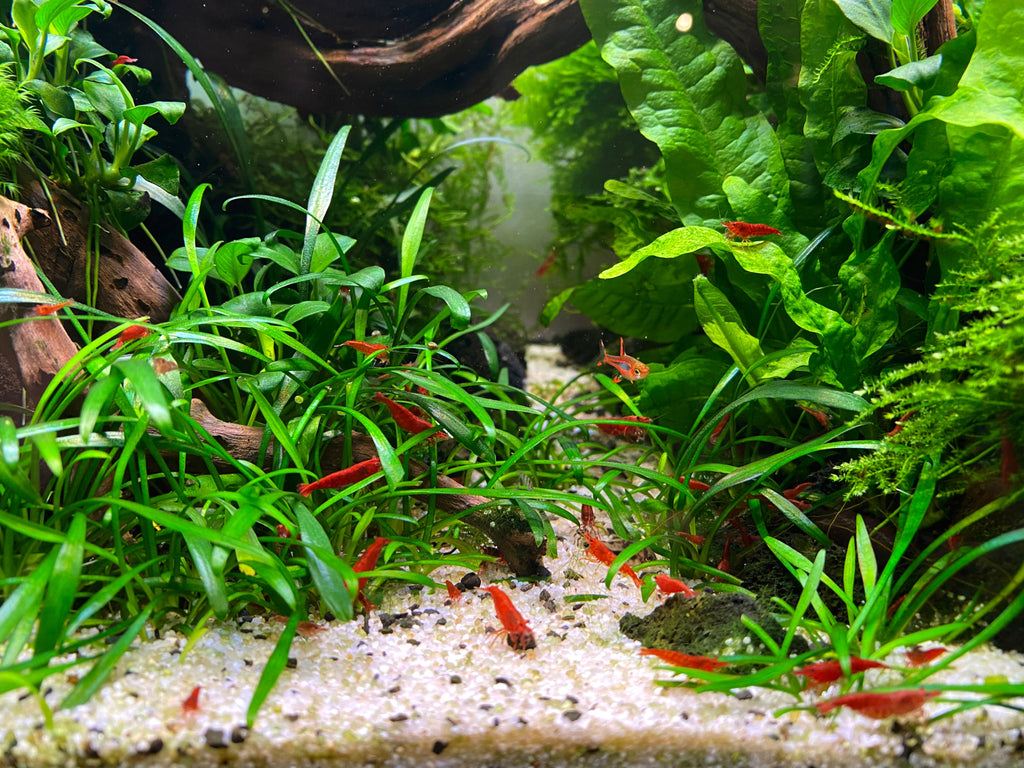Your Cart is Empty
What is a good level of GH in a planted aquarium?
January 20, 2025 3 min read

The GH in this aquarium above was around 10-12 dGH, with KH levels around 8-11 dKH due to the limestone used in the aquarium. Limestone (CaCO3) dissolves slowly in water, adding both calcium and carbonates to the water. We would classify these water parameters as moderately hard.
General Hardness (GH)
Despite its fancy name, GH only measures the total amount of Ca/Mg ions (and other divalent cations) in the water. Calcium is present in most tap water. However, magnesium is often overlooked. If your tank has a high GH, it is possible that it is all calcium ions and no magnesium is present - in which case magnesium still needs to be added for the plants.
GH is most commonly measured in degrees, where 1 dGH is the amount of calcium present when 17.8ppm (parts per million) of calcium carbonate (CaCO3) is dissolved in 1 litre of water. This can be a confusing definition for aquarists as GH only counts the amount of calcium/magnesium present, but using dGH as a unit means that calcium values are referred to in terms of units of calcium carbonate dissolved per litre of water.
17.8ppm of calcium carbonate dissolved in 1 litre of water (which is 1dGH) actually gives only 7.1ppm of calcium (and 10.7ppm of carbonates). Having 7.1ppm of calcium in your water is equivalent to having 1dGH. Hobbyists often make the mistake of converting dGH to ppm in terms of calcium by simply multiplying the dGH value by 17.8, which is wrong because it includes the mass of the carbonate (CO3) anion;
In short:
1 dGH = 7.1ppm calcium = 0.178 mmol/L calcium ions
1 dGH = 4.3ppm magnesium = 0.178 mmol/L magnesium ions
For example, if you have 14.2ppm Calcium and 4.3ppm Magnesium in your tap water, then you have exactly 3 dGH (2 dGH Calcium + 1 dGH Magnesium). In another example, if you have zero calcium and 43ppm magnesium in your water, you would still have water that measures 10 dGH. The dGH measurement/reading does not distinguish between Calcium and Magnesium (or other divalent ions). Calcium and magnesium are both required by plants, while some animals such as shrimp require calcium but not magnesium. Therefore, the use of dGH measurement is really an imprecise tool for managing tank parameters compared to directly measuring calcium and magnesium levels.

Seiryu rock is a popular rock used in aquascaping. However, Seiryu is a type of weathered limestone and will increase both GH and KH. Aquariums using Seiryu rock should avoid plant and fish species that require very soft water.
Generally, hard tap water comes from limestone (CaCO3) regions - so it is much more common to see high GH values with correspondingly high KH values (which measure the carbonates present). However, these levels do not have to match. It is possible to have high GH, low KH water. (It is also possible to have low GH, high KH water. (Low levels of Ca/Mg in the water, but high levels of carbonates).
Reading your local water report is an easy way to find out what is in your tap water. Follow this link to read your tap water report.
Plants and livestock are generally less sensitive to GH than to KH. Plants that need soft water to grow well need low KH levels, but not necessarily low GH levels. These plants are more sensitive to alkalinity than to general hardness. GH, or more specifically calcium, is important when keeping shrimp and crustaceans.
Aquariums with soft water plants typically have GH values as low as 1-3 dGH, and most soft water plants grow well in this range. While very hard water tanks can have GH levels in the 20+ dGH range. Shrimps and snails appreciate calcium in the water, 5-8 dGH is a good range.

As calcium is present in most tap water, calcium deficiency in planted aquariums is very rare. Almost all cases of tip stunting attributed to calcium deficiency are misdiagnosed and instead caused by other variables. Some species such as Rotala florida, Cryptocoryne flamingo and Pogostemon helferi appreciate higher calcium levels. 5-7 dGH is a good level for these species. They will grow faster and more robust with sufficient calcium in the water.
Some sensitive species such as Rotala macrandra also do better when magnesium levels are adequate.

Having 15ppm of Calcium and 5ppm of Magnesium will work well for most tanks. Having 30-50ppm of calcium will be better for shrimp/shellfish and for plants that prefer higher calcium levels.
GH is often confused with KH, read about KH under here.
unlock your true potential
Grow anything, defeat algae, create amazing aquascapes

























